Benzyl 4-(chlorocarbonyl)-1-piperidinecarboxylate
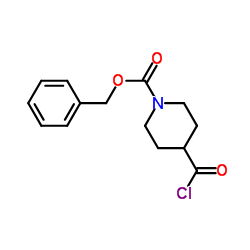
Benzyl 4-(chlorocarbonyl)-1-piperidinecarboxylate structure
|
Common Name | Benzyl 4-(chlorocarbonyl)-1-piperidinecarboxylate | ||
|---|---|---|---|---|
| CAS Number | 10314-99-5 | Molecular Weight | 281.735 | |
| Density | 1.3±0.1 g/cm3 | Boiling Point | 396.6±42.0 °C at 760 mmHg | |
| Molecular Formula | C14H16ClNO3 | Melting Point | N/A | |
| MSDS | N/A | Flash Point | 193.6±27.9 °C | |
| Name | benzyl 4-carbonochloridoylpiperidine-1-carboxylate |
|---|---|
| Synonym | More Synonyms |
| Density | 1.3±0.1 g/cm3 |
|---|---|
| Boiling Point | 396.6±42.0 °C at 760 mmHg |
| Molecular Formula | C14H16ClNO3 |
| Molecular Weight | 281.735 |
| Flash Point | 193.6±27.9 °C |
| Exact Mass | 281.081879 |
| PSA | 46.61000 |
| LogP | 2.40 |
| Vapour Pressure | 0.0±0.9 mmHg at 25°C |
| Index of Refraction | 1.557 |
| InChIKey | KUBUQFFBRSHOMJ-UHFFFAOYSA-N |
| SMILES | O=C(Cl)C1CCN(C(=O)OCc2ccccc2)CC1 |
Synonym:4-Chlorocarbonylpiperidine-1-carboxylic acid benzyl este Section 2 - COMPOSITION, INFORMATION ON INGREDIENTS
Risk Phrases: 34 Section 3 - HAZARDS IDENTIFICATION EMERGENCY OVERVIEW
Causes burns.Moisture sensitive. Potential Health Effects Eye: Causes eye burns. Skin: Causes skin burns. Ingestion: Causes gastrointestinal tract burns. Inhalation: Causes chemical burns to the respiratory tract. Chronic: Not available. Section 4 - FIRST AID MEASURES Eyes: Immediately flush eyes with plenty of water for at least 15 minutes, occasionally lifting the upper and lower eyelids. Get medical aid immediately. Skin: Get medical aid immediately. Immediately flush skin with plenty of water for at least 15 minutes while removing contaminated clothing and shoes. Ingestion: Do not induce vomiting. Get medical aid immediately. Inhalation: Get medical aid immediately. Remove from exposure and move to fresh air immediately. If not breathing, give artificial respiration. If breathing is difficult, give oxygen. Notes to Physician: Treat symptomatically and supportively. Section 5 - FIRE FIGHTING MEASURES General Information: As in any fire, wear a self-contained breathing apparatus in pressure-demand, MSHA/NIOSH (approved or equivalent), and full protective gear. Extinguishing Media: Use foam, dry chemical, or carbon dioxide. Section 6 - ACCIDENTAL RELEASE MEASURES General Information: Use proper personal protective equipment as indicated in Section 8. Spills/Leaks: Absorb spill with inert material (e.g. vermiculite, sand or earth), then place in suitable container. Section 7 - HANDLING and STORAGE Handling: Do not breathe dust, vapor, mist, or gas. Do not get in eyes, on skin, or on clothing. Use only in a chemical fume hood. Storage: Store in a cool, dry place. Store in a tightly closed container. Corrosives area. Store under nitrogen. Section 8 - EXPOSURE CONTROLS, PERSONAL PROTECTION Engineering Controls: Facilities storing or utilizing this material should be equipped with an eyewash facility and a safety shower. Use adequate ventilation to keep airborne concentrations low. Exposure Limits CAS# 10314-99-5: Personal Protective Equipment Eyes: Not available. Skin: Wear appropriate protective gloves to prevent skin exposure. Clothing: Wear appropriate protective clothing to prevent skin exposure. Respirators: Follow the OSHA respirator regulations found in 29 CFR 1910.134 or European Standard EN 149. Use a NIOSH/MSHA or European Standard EN 149 approved respirator if exposure limits are exceeded or if irritation or other symptoms are experienced. Section 9 - PHYSICAL AND CHEMICAL PROPERTIES Physical State: Viscous liquid Color: Clear Odor: characteristic odor pH: Not available. Vapor Pressure: Not available. Viscosity: Not available. Boiling Point: Not available. Freezing/Melting Point: Not available. Autoignition Temperature: Not available. Flash Point: Not available. Explosion Limits, lower: Not available. Explosion Limits, upper: Not available. Decomposition Temperature: Solubility in water: Specific Gravity/Density: Molecular Formula: C14H16ClNO3 Molecular Weight: 282 Section 10 - STABILITY AND REACTIVITY Chemical Stability: Not available. Conditions to Avoid: Incompatible materials, exposure to moist air or water. Incompatibilities with Other Materials: Strong oxidizing agents, reducing agents, acids, bases, alcohols, amines. Hazardous Decomposition Products: Hydrogen chloride, chlorine, nitrogen oxides, carbon monoxide, carbon dioxide, acrid smoke and fumes. Hazardous Polymerization: Has not been reported Section 11 - TOXICOLOGICAL INFORMATION RTECS#: CAS# 10314-99-5 unlisted. LD50/LC50: Not available. Carcinogenicity: Benzyl 4-(chlorocarbonyl)tetrahydro-1(2H)-pyridinecarboxylate - Not listed by ACGIH, IARC, or NTP. Section 12 - ECOLOGICAL INFORMATION Section 13 - DISPOSAL CONSIDERATIONS Dispose of in a manner consistent with federal, state, and local regulations. Section 14 - TRANSPORT INFORMATION IATA Shipping Name: CORROSIVE LIQUID, ACIDIC, ORGANIC, N.O.S.* Hazard Class: 8 UN Number: 3265 Packing Group: III IMO Shipping Name: CORROSIVE LIQUID, ACIDIC, ORGANIC, N.O.S. Hazard Class: 8 UN Number: 3265 Packing Group: III RID/ADR Shipping Name: CORROSIVE LIQUID, ACIDIC, ORGANIC, N.O.S. Hazard Class: 8 UN Number: 3265 Packing group: III Section 15 - REGULATORY INFORMATION European/International Regulations European Labeling in Accordance with EC Directives Hazard Symbols: C Risk Phrases: R 34 Causes burns. Safety Phrases: S 26 In case of contact with eyes, rinse immediately with plenty of water and seek medical advice. S 36/37/39 Wear suitable protective clothing, gloves and eye/face protection. S 45 In case of accident or if you feel unwell, seek medical advice immediately (show the label where possible). WGK (Water Danger/Protection) CAS# 10314-99-5: No information available. Canada None of the chemicals in this product are listed on the DSL/NDSL list. CAS# 10314-99-5 is not listed on Canada's Ingredient Disclosure List. US FEDERAL TSCA CAS# 10314-99-5 is not listed on the TSCA inventory. It is for research and development use only. SECTION 16 - ADDITIONAL INFORMATION N/A |
| Hazard Codes | C: Corrosive; |
|---|---|
| Risk Phrases | R34 |
| Safety Phrases | 26-36/37/39 |
| RIDADR | UN 3265 |
| HS Code | 2933399090 |
|
~94% 
Benzyl 4-(chlor... CAS#:10314-99-5 |
| Literature: Boxus, Thierry; Touillaux, Roland; Dive, Georges; Marchand-Brynaert, Jacqueline Bioorganic and Medicinal Chemistry, 1998 , vol. 6, # 9 p. 1577 - 1595 |
|
~% 
Benzyl 4-(chlor... CAS#:10314-99-5 |
| Literature: Bioorganic and Medicinal Chemistry, , vol. 13, # 2 p. 397 - 416 |
|
~% 
Benzyl 4-(chlor... CAS#:10314-99-5 |
| Literature: Bioorganic and medicinal chemistry letters, , vol. 12, # 6 p. 967 - 970 |
| Precursor 3 | |
|---|---|
| DownStream 10 | |
| HS Code | 2933399090 |
|---|---|
| Summary | 2933399090. other compounds containing an unfused pyridine ring (whether or not hydrogenated) in the structure. VAT:17.0%. Tax rebate rate:13.0%. . MFN tariff:6.5%. General tariff:20.0% |
| 1-Piperidinecarboxylic acid, 4-(chlorocarbonyl)-, phenylmethyl ester |
| Benzyl 4-(chlorocarbonyl)piperidine-1-carboxylate |
| 4-chlorocarbonyl-piperidine-1-carboxylic acid benzyl ester |
| 1-benzyloxycarbonyl-piperidine-4-carbonyl chloride |
| MFCD03407318 |
| Benzyl 4-(chlorocarbonyl)-1-piperidinecarboxylate |
| 1-benzyloxycarbonylpiperidine-4-carboxylic acid chloride |


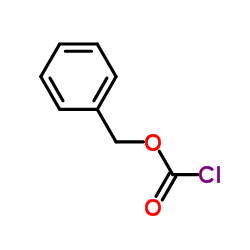
 CAS#:30672-46-9
CAS#:30672-46-9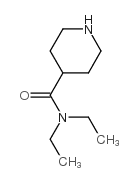 CAS#:1903-67-9
CAS#:1903-67-9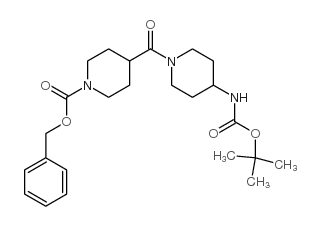 CAS#:220031-94-7
CAS#:220031-94-7![benzyl spiro[indole-3,4'-piperidine]-1'-carboxylate structure](https://image.chemsrc.com/caspic/019/184289-85-8.png) CAS#:184289-85-8
CAS#:184289-85-8 CAS#:159874-20-1
CAS#:159874-20-1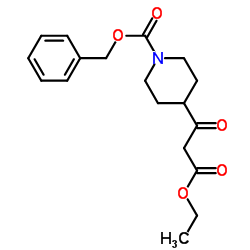 CAS#:167414-75-7
CAS#:167414-75-7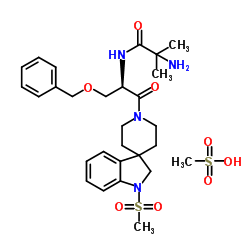 CAS#:159634-47-6
CAS#:159634-47-6![1-(METHYLSULFONYL)SPIRO[INDOLINE-3,4'-PIPERIDINE] structure](https://image.chemsrc.com/caspic/179/178261-41-1.png) CAS#:178261-41-1
CAS#:178261-41-1 CAS#:220394-91-2
CAS#:220394-91-2![Benzyl spiro[indoline-3,4'-piperidine]-1'-carboxylate structure](https://image.chemsrc.com/caspic/399/167484-18-6.png) CAS#:167484-18-6
CAS#:167484-18-6